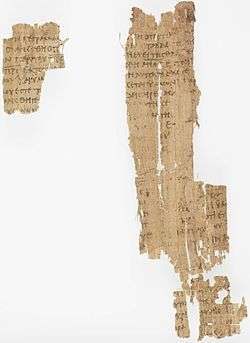John 15
John 15 is the fifteenth chapter in the Gospel of John in the New Testament section of the Christian Bible. It is part of what New Testament scholars have called the 'farewell discourse' of Jesus. It has historically been a source of Christian teaching, Christological debate and reflection, and its images (particularly of Jesus as the vine) have been influential in Christian art and iconography. The chapter implies one of the highest and most developed Christologies to be found in the New Testament. The original text was written in Koine Greek.
| John 15 | |
|---|---|
 John 15:25-16:2 on the recto side of Papyrus 22, written about AD 250. | |
| Book | Gospel of John |
| Category | Gospel |
| Christian Bible part | New Testament |
| Order in the Christian part | 4 |
Text
The original text was written in Koine Greek. This chapter is divided into 27 verses.
Textual witnesses
Some early manuscripts containing the text of this chapter are:[lower-alpha 1]
- Codex Vaticanus (325-350; complete)
- Codex Sinaiticus (330-360; complete)
- Codex Bezae (~400; complete)
- Codex Alexandrinus (400-440; complete)
Places
The events and discourses recorded in this chapter and in the whole of chapters 13 to 17 took place in Jerusalem. The precise location is not specified, but John 18:1 states that afterwards, "Jesus left with his disciples and crossed the Kidron Valley". Because the previous chapter ends with the words "Come now, let us go",[2] Plummer, in the Cambridge Bible for Schools and Colleges, suggests that Jesus and His disciples have "rise[n] from table and prepare[d] to depart, but that the contents of the next three chapters (15-17) are spoken before they leave the room".[3]
Analysis
The chapter presents Jesus speaking in the first person. Although ostensibly addressing his disciples, most scholars conclude the chapter is written with events concerning the later church in mind. Jesus is presented as explaining the relationship between himself and his followers - seeking to model this relationship on his own relationship with his Father.
The chapter introduces the extended metaphor of Christ as the true vine. The Father is the vinedresser, vinegrower or husbandman.[4] His disciples are said to be branches (Greek: τα κληματα, ta klémata, specifically meaning vine branches) [5] which must 'abide' in him if they are to 'bear fruit'. The disciples are warned that barren branches are pruned by the vinedresser: see John 15:2: Every branch that does bear fruit is pruned so that it will bear more fruit - not barren branches.
The chapter proceeds by comparing the close relationship of Jesus and his disciples ('abiding') to that of himself and his Father. Disciples are reminded of the love of the Father and the Son - the love of the Son for the disciples, and then indicted to 'love one another' in the same manner. Verse 13 speaks of the 'greater love' as being the willingness to 'lay down' one's life for friends. This text, which primarily refers to Jesus’ impending death, has since been widely used to affirm the sacrifice of martyrs and soldiers in war, and is thus often seen on war memorials and graves.
Jesus then speaks of being hated by the world (verses 18-25), but He sees this hatred as fulfillment of the words in either Psalm 69, "They hated Me without a cause".[6] or Psalm 35, "neither let them wink with the eye that hate me without a cause".[7]
The chapter concludes by warning disciples to expect persecution and promises the gift of the parakletos (paraclete or Holy Spirit). The reference to the Spirit in verse 26, speaks of it as sent by the Son from the Father. This verse has been particularly influential in debates concerning the nature of the Trinity and in the filioque disputes between Eastern and Western Christianity.

Notes
- The extant Codex Ephraemi Rescriptus does not have this chapter due to lacuna.[1]
References
- Eberhard Nestle, Erwin Nestle, Barbara Aland and Kurt Aland (eds), Novum Testamentum Graece, 26th edition, (Stuttgart: Deutsche Bibelgesellschaft, 1991), p. 689.
- Jerusalem Bible, John 14:31
- Plummer, A. (1902), Cambridge Bible for Schools and Colleges on John 14, accessed 5 July 2016
- BibleGateway.com, English translations of John 15:1
- Strong's Greek Concordance, 2814: kléma, accessed 2 June 2019
- Psalm 69:4
- Psalm 35:19
- Kirkpatrick 1901, p. 838.
- Kirkpatrick 1901, p. 839.
Bibliography
- Bultmann, Rudolf The Gospel of John Blackwell 1971
- Kirkpatrick, A. F. (1901). The Book of Psalms: with Introduction and Notes. The Cambridge Bible for Schools and Colleges. Book IV and V: Psalms XC-CL. Cambridge: At the University Press. Retrieved February 28, 2019.
- Linders, Barnabas The Gospel of John Marshall Morgan and Scott 1972
External links
| Wikimedia Commons has media related to Gospel of John - Chapter 15. |
- John 15 King James Bible - Wikisource
- English Translation with Parallel Latin Vulgate
- Online Bible at GospelHall.org (ESV, KJV, Darby, American Standard Version, Bible in Basic English)
- Multiple bible versions at Bible Gateway (NKJV, NIV, NRSV etc.)
- The Holy Bible, English Standard Version, quoting John 15 with footnotes
| Preceded by John 14 |
Chapters of the Bible Gospel of John |
Succeeded by John 16 |